AuIII Acyclic (Amino)(N-Pyridinium)carbenoids: Synthesis via Addition of 2-PySeCl to AuI-Bound Isonitriles, Structures, and Cytotoxicity
Abstract
1. Introduction
2. Results and Discussion
3. Methods
3.1. Experimental Details

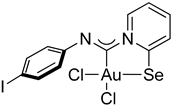
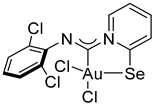
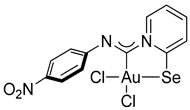
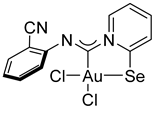
Reaction of [(tBuNC)AuCl] with 2-PySeCl
3.2. Theoretical Methods
4. Conclusions
Supplementary Materials
Author Contributions
Funding
Data Availability Statement
Acknowledgments
Conflicts of Interest
References
- Hopkinson, M.N.; Richter, C.; Schedler, M.; Glorius, F. An overview of N-heterocyclic carbenes. Nature 2014, 510, 485–496. [Google Scholar] [CrossRef]
- Cardin, D.J.; Cetinkaya, B.; Lappert, M.F.; Manojlović-Muir, L.; Muir, K.W. An electron-rich olefin as a source of co-ordinated carbene; synthesis of trans-PtCl2[C(NPhCH2)2]PEt3. J. Chem. Soc. D Chem. Commun. 1971, 400–401. [Google Scholar] [CrossRef]
- Cardin, D.J.; Cetinkaya, B.; Lappert, M.F. Transition metal-carbene complexes. Chem. Rev. 1972, 72, 545–574. [Google Scholar] [CrossRef]
- Slaughter, L.M. Acyclic aminocarbenes in catalysis. ACS Catal. 2012, 2, 1802–1816. [Google Scholar] [CrossRef]
- Nelson, D.J.; Nolan, S.P. N-Heterocyclic Carbenes. In N-Heterocyclic Carbenes; Wiley: Hoboken, NJ, USA, 2014; pp. 1–24. ISBN 9783527671229. [Google Scholar]
- Arduengo, A.J.; Goerlich, J.R.; Marshall, W.J. A stable diaminocarbene. J. Am. Chem. Soc. 2002, 117, 11027–11028. [Google Scholar] [CrossRef]
- Benhamou, L.; Chardon, E.; Lavigne, G.; Bellemin-Laponnaz, S.; César, V. Synthetic Routes to N-Heterocyclic Carbene Precursors. Chem. Rev. 2011, 111, 2705–2733. [Google Scholar] [CrossRef] [PubMed]
- Riener, K.; Haslinger, S.; Raba, A.; Högerl, M.P.; Cokoja, M.; Herrmann, W.A.; Kühn, F.E. Chemistry of Iron N-Heterocyclic Carbene Complexes: Syntheses, Structures, Reactivities, and Catalytic Applications. Chem. Rev. 2014, 114, 5215–5272. [Google Scholar] [CrossRef]
- Jayaraj, A.; Raveedran, A.V.; Latha, A.T.; Priyadarshini, D.; Swamy, P.C.A. Coordination Versatility of NHC-metal Topologies in Asymmetric Catalysis: Synthetic Insights and Recent Trends. Coord. Chem. Rev. 2023, 478, 214922. [Google Scholar] [CrossRef]
- Bellotti, P.; Koy, M.; Hopkinson, M.N.; Glorius, F. Recent advances in the chemistry and applications of N-heterocyclic carbenes. Nat. Rev. Chem. 2021, 5, 711–725. [Google Scholar] [CrossRef] [PubMed]
- Maurya, A.; Tyagi, R. Acyclic diaminocarbenes (ADCs) and their catalytic activity in metal catalysed organic transformation reactions. Rev. Inorg. Chem. 2024, 44, 255–270. [Google Scholar] [CrossRef]
- Zhou, T.; Utecht-Jarzyńska, G.; Szostak, M. Ring-expanded N-heterocyclic carbene (reNHC) complexes: Applications in transition metal catalysis. Coord. Chem. Rev. 2024, 512, 215867. [Google Scholar] [CrossRef]
- Zhao, Q.; Han, B.; Peng, C.; Zhang, N.; Huang, W.; He, G.; Li, J.-L. A promising future of metal-N-heterocyclic carbene complexes in medicinal chemistry: The emerging bioorganometallic antitumor agents. Med. Res. Rev. 2024, 44, 2194–2235. [Google Scholar] [CrossRef]
- Denk, K.; Sirsch, P.; Herrmann, W.A. The first metal complexes of bis(diisopropylamino)carbene: Synthesis, structure and ligand properties. J. Organomet. Chem. 2002, 649, 219–224. [Google Scholar] [CrossRef]
- Boyarskiy, V.P.; Bokach, N.A.; Luzyanin, K.V.; Kukushkin, V.Y. Metal-Mediated and Metal-Catalyzed Reactions of Isocyanides. Chem. Rev. 2015, 115, 2698–2779. [Google Scholar] [CrossRef]
- Bolotin, D.S.; Bokach, N.A.; Kritchenkov, A.S.; Haukka, M.; Kukushkin, V.Y. Amidrazone Complexes from a Cascade Platinum(II)-Mediated Reaction between Amidoximes and Dialkylcyanamides. Inorg. Chem. 2013, 52, 6378–6389. [Google Scholar] [CrossRef] [PubMed]
- Tskhovrebov, A.G.; Goddard, R.; Fürstner, A. Two Amphoteric Silver Carbene Clusters. Angew. Chemie Int. Ed. 2018, 57, 8089–8094. [Google Scholar] [CrossRef] [PubMed]
- Kritchenkov, A.S.; Luzyanin, K.V.; Bokach, N.A.; Kuznetsov, M.L.; Gurzhiy, V.V.; Kukushkin, V.Y. Selective Nucleophilic Oxygenation of Palladium-Bound Isocyanide Ligands: Route to Imine Complexes That Serve as Efficient Catalysts for Copper-/Phosphine-Free Sonogashira Reactions. Organometallics 2013, 32, 1979–1987. [Google Scholar] [CrossRef]
- Luzyanin, K.V.; Tskhovrebov, A.G.; Carolina Carias, M.; da Silva, M.F.C.G.; Pombeiro, A.J.L.; Kukushkin, V.Y. Novel Metal-mediated (M = Pd, Pt) coupling between isonitriles and benzophenone hydrazone as a route to aminocarbene complexes exhibiting high catalytic activity (M = Pd) in the Suzuki-Miyaura reaction. Organometallics 2009, 28, 6559–6566. [Google Scholar] [CrossRef]
- Luzyanin, K.V.; Tskhovrebov, A.G.; Guedes da Silva, M.F.C.; Haukka, M.; Pombeiro, A.J.L.; Kukushkin, V.Y. Metal-mediated [2+3] cycloaddition of nitrones to palladium-bound isonitriles. Chem. A Eur. J. 2009, 15, 5969–5978. [Google Scholar] [CrossRef] [PubMed]
- Luzyanin, K.V.; Pombeiro, A.J.L. Carbene Complexes Derived from Metal-Bound Isocyanides: Recent Advances. In Isocyanide Chemistry; Wiley: Hoboken, NJ, USA, 2012; pp. 531–550. ISBN 9783527652532. [Google Scholar]
- Tskhovrebov, A.G.; Luzyanin, K.V.; Dolgushin, F.M.; Guedes Da Silva, M.F.C.; Pombeiro, A.J.L.; Kukushkin, V.Y. Novel reactivity mode of metal diaminocarbenes: Palladium(II)-mediated coupling between acyclic diaminocarbenes and isonitriles leading to dinuclear species. Organometallics 2011, 30, 3362–3370. [Google Scholar] [CrossRef]
- Tskhovrebov, A.G.; Luzyanin, K.V.; Kuznetsov, M.L.; Sorokoumov, V.N.; Balova, I.A.; Haukka, M.; Kukushkin, V.Y. Substituent R-dependent regioselectivity switch in nucleophilic addition of N-phenylbenzamidine to PdII-and PtII-complexed isonitrile RN-C giving aminocarbene-like species. Organometallics 2011, 30, 863–874. [Google Scholar] [CrossRef]
- Mikhaylov, V.N.; Sorokoumov, V.N.; Liakhov, D.M.; Tskhovrebov, A.G.; Balova, I.A. Polystyrene-supported acyclic diaminocarbene palladium complexes in Sonogashira cross-coupling: Stability vs. catalytic activity. Catalysts 2018, 8, 141. [Google Scholar] [CrossRef]
- Mikhaylov, V.N.; Sorokoumov, V.N.; Novikov, A.S.; Melnik, M.V.; Tskhovrebov, A.G.; Balova, I.A. Intramolecular hydrogen bonding stabilizes trans-configuration in a mixed carbene/isocyanide PdII complexes. J. Organomet. Chem. 2020, 912, 121174. [Google Scholar] [CrossRef]
- Usón, R.; Laguna, A.; Vicente, J.; García, J.; Bergareche, B.; Brun, P. Neutral isocyanide and carbene pentafluorophenyl complexes of gold(I) and gold(III). Inorganica Chim. Acta 1978, 28, 237–243. [Google Scholar] [CrossRef]
- Usón, R.; Laguna, A.; Vicente, J.; García, J.; Bergareche, B. Preparation of pentahalophenyl p-tolylisocyanide complexes of gold(I) and their reactions with amines, ammonia and alcohols. J. Organomet. Chem. 1979, 173, 349–355. [Google Scholar] [CrossRef]
- Parks, J.E.; Balch, A.L. Gold carbene complexes: Preparation, oxidation, and ligand displacement. J. Organomet. Chem. 1974, 71, 453–463. [Google Scholar] [CrossRef]
- Minghetti, G.; Bonati, F. Bis(carbene) complexes of gold(I) and gold (III). J. Organomet. Chem. 1973, 54, C62–C63. [Google Scholar] [CrossRef]
- Tskhovrebov, A.G.; Luzyanin, K.V.; Haukka, M.; Kukushkin, V.Y. Synthesis and characterization of cis-(RNC)2PtII species useful as synthons for generation of various (aminocarbene)Pt II complexes. J. Chem. Crystallogr. 2012, 42, 1170–1175. [Google Scholar] [CrossRef]
- Ruch, A.A.; Ellison, M.C.; Nguyen, J.K.; Kong, F.; Handa, S.; Nesterov, V.N.; Slaughter, L.M. Highly Sterically Encumbered Gold Acyclic Diaminocarbene Complexes: Overriding Electronic Control in Regiodivergent Gold Catalysis. Organometallics 2021, 40, 1416–1433. [Google Scholar] [CrossRef]
- Khrakovsky, D.A.; Tao, C.; Johnson, M.W.; Thornbury, R.T.; Shevick, S.L.; Toste, F.D. Enantioselective, Stereodivergent Hydroazidation and Hydroamination of Allenes Catalyzed by Acyclic Diaminocarbene (ADC) Gold(I) Complexes. Angew. Chemie Int. Ed. 2016, 55, 6079–6083. [Google Scholar] [CrossRef] [PubMed]
- Zuccarello, G.; Nannini, L.J.; Arroyo-Bondía, A.; Fincias, N.; Arranz, I.; Pérez-Jimeno, A.H.; Peeters, M.; Martín-Torres, I.; Sadurní, A.; García-Vázquez, V.; et al. Enantioselective Catalysis with Pyrrolidinyl Gold(I) Complexes: DFT and NEST Analysis of the Chiral Binding Pocket. JACS Au 2023, 3, 1742–1754. [Google Scholar] [CrossRef] [PubMed]
- Montanel-Pérez, S.; Elizalde, R.; Laguna, A.; Villacampa, M.D.; Gimeno, M.C. Synthesis of Bioactive N-Acyclic Gold(I) and Gold(III) Diamino Carbenes with Different Ancillary Ligands. Eur. J. Inorg. Chem. 2019, 2019, 4273–4281. [Google Scholar] [CrossRef]
- Iacopetta, D.; Rosano, C.; Sirignano, M.; Mariconda, A.; Ceramella, J.; Ponassi, M.; Saturnino, C.; Sinicropi, M.S.; Longo, P. Is the Way to Fight Cancer Paved with Gold? Metal-Based Carbene Complexes with Multiple and Fascinating Biological Features. Pharmaceuticals 2020, 13, 91. [Google Scholar] [CrossRef]
- Weaver, J.; Gaillard, S.; Toye, C.; Macpherson, S.; Nolan, S.P.; Riches, A. Cytotoxicity of Gold(I) N-Heterocyclic Carbene Complexes Assessed by Using Human Tumor Cell Lines. Chem. A Eur. J. 2011, 17, 6620–6624. [Google Scholar] [CrossRef] [PubMed]
- Bertrand, B.; Romanov, A.S.; Brooks, M.; Davis, J.; Schmidt, C.; Ott, I.; O’Connell, M.; Bochmann, M. Synthesis, structure and cytotoxicity of cyclic (alkyl)(amino) carbene and acyclic carbene complexes of group 11 metals. Dalt. Trans. 2017, 46, 15875–15887. [Google Scholar] [CrossRef]
- Chan, S.-L.; Chun, Y.-K.; Ko, C.-C. Transition-metal acyclic carbene complexes: Building blocks for luminescent, stimuli-responsive, bioactive materials and catalysts. Mater. Chem. Front. 2023, 7, 2958–2972. [Google Scholar] [CrossRef]
- Chen, C.; Zhou, L.; Xie, B.; Wang, Y.; Ren, L.; Chen, X.; Cen, B.; Lv, H.; Wang, H. Novel fast-acting pyrazole/pyridine-functionalized N-heterocyclic carbene silver complexes assembled with nanoparticles show enhanced safety and efficacy as anticancer therapeutics. Dalt. Trans. 2020, 49, 2505–2516. [Google Scholar] [CrossRef] [PubMed]
- Martínez-Junquera, M.; Lalinde, E.; Moreno, M.T.; Alfaro-Arnedo, E.; López, I.P.; Larráyoz, I.M.; Pichel, J.G. Luminescent cyclometalated platinum(ii) complexes with acyclic diaminocarbene ligands: Structural, photophysical and biological properties. Dalt. Trans. 2021, 50, 4539–4554. [Google Scholar] [CrossRef] [PubMed]
- Jazzar, R.; Soleilhavoup, M.; Bertrand, G. Cyclic (Alkyl)- and (Aryl)-(amino)carbene Coinage Metal Complexes and Their Applications. Chem. Rev. 2020, 120, 4141–4168. [Google Scholar] [CrossRef] [PubMed]
- Beerhues, J.; Neubrand, M.; Sobottka, S.; Neuman, N.I.; Aberhan, H.; Chandra, S.; Sarkar, B. Directed Design of a AuI Complex with a Reduced Mesoionic Carbene Radical Ligand: Insights from 1,2,3-Triazolylidene Selenium Adducts and Extensive Electrochemical Investigations. Chem. A Eur. J. 2021, 27, 6557–6568. [Google Scholar] [CrossRef] [PubMed]
- Mikherdov, A.S.; Baikov, S.V.; Proskurina, I.K.; Shetnev, A.A.; Kotov, A.D. Synthesis and Properties of C,N-Chelated Carbene Complexes of Palladium(II) with 2-Aminobenzo[d]thiazole Fragment. Russ. J. Gen. Chem. 2019, 89, 2062–2068. [Google Scholar] [CrossRef]
- Mikherdov, A.S.; Orekhova, Y.A.; Boyarskii, V.P. Formation of Homo- and Heteronuclear Platinum(II) and Palladium(II) Carbene Complexes in the Reactions of Coordinated Isocyanides with Aminothiazaheterocycles. Russ. J. Gen. Chem. 2018, 88, 2119–2124. [Google Scholar] [CrossRef]
- Zhang, C.; Maddelein, M.-L.; Wai-Yin Sun, R.; Gornitzka, H.; Cuvillier, O.; Hemmert, C. Pharmacomodulation on Gold-NHC complexes for anticancer applications—Is lipophilicity the key point? Eur. J. Med. Chem. 2018, 157, 320–332. [Google Scholar] [CrossRef] [PubMed]
- La Manna, S.; Marasco, D. Insights into molecular mechanisms of metallodrugs using metallomic studies. Inorganica Chim. Acta 2024, 560, 121816. [Google Scholar] [CrossRef]
- Neese, F. The ORCA program system. WIREs Comput. Mol. Sci. 2012, 2, 73–78. [Google Scholar] [CrossRef]
- Adamo, C.; Barone, V. Toward reliable density functional methods without adjustable parameters: The PBE0 model. J. Chem. Phys. 1999, 110, 6158–6170. [Google Scholar] [CrossRef]
- Caldeweyher, E.; Ehlert, S.; Hansen, A.; Neugebauer, H.; Spicher, S.; Bannwarth, C.; Grimme, S. A generally applicable atomic-charge dependent London dispersion correction. J. Chem. Phys. 2019, 150, 154122. [Google Scholar] [CrossRef] [PubMed]
- Weigend, F. Accurate Coulomb-fitting basis sets for H to Rn. Phys. Chem. Chem. Phys. 2006, 8, 1057–1065. [Google Scholar] [CrossRef] [PubMed]
- Ásgeirsson, V.; Birgisson, B.O.; Bjornsson, R.; Becker, U.; Neese, F.; Riplinger, C.; Jónsson, H. Nudged Elastic Band Method for Molecular Reactions Using Energy-Weighted Springs Combined with Eigenvector Following. J. Chem. Theory Comput. 2021, 17, 4929–4945. [Google Scholar] [CrossRef]






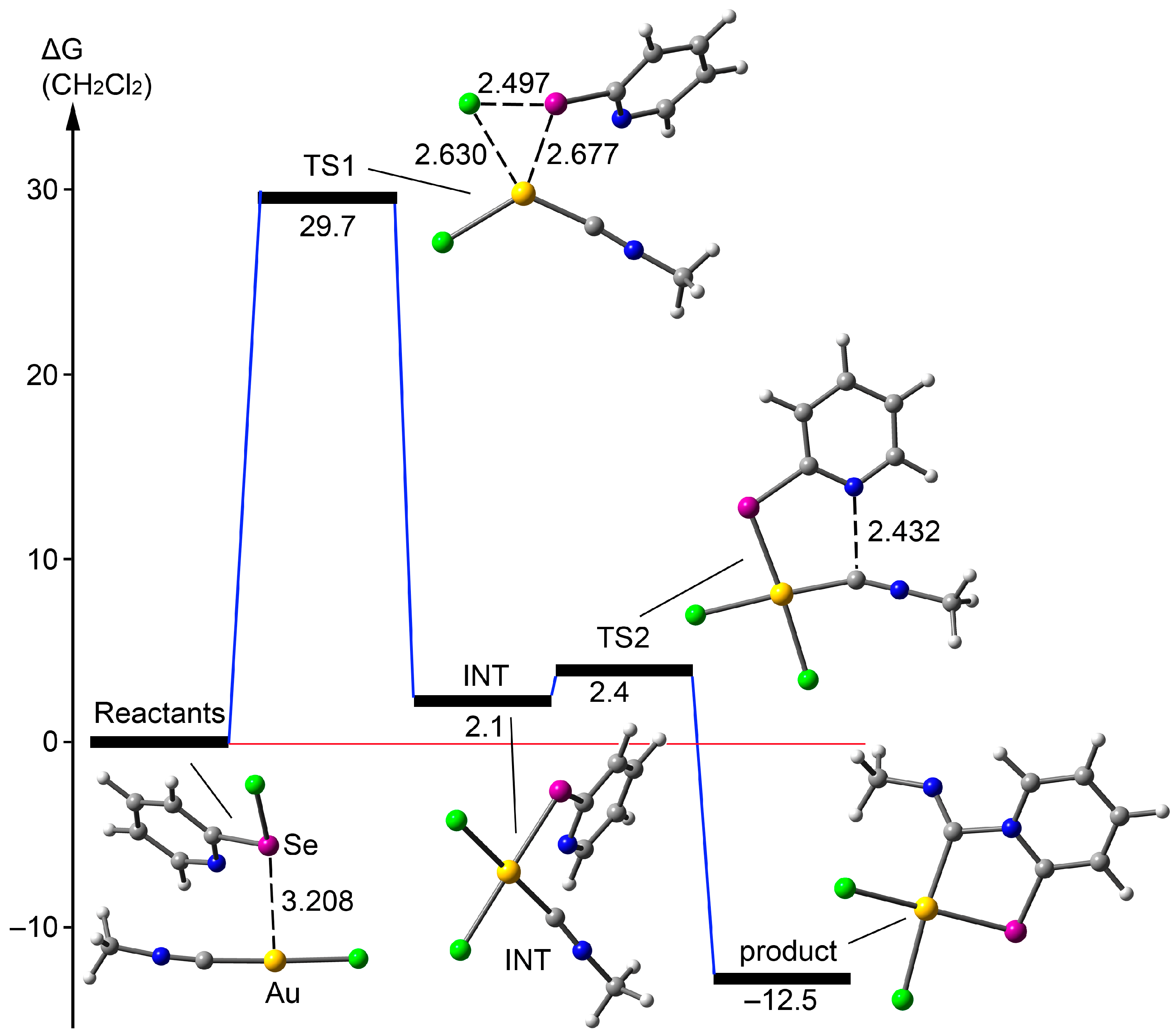
| Parameter | 2a | 2c | 2d | 2e |
|---|---|---|---|---|
| Au−Cl | 2.244(2)–2.357(2) | 2.330(3)–2.354(3) | 2.3371(14)–2.3427(13) | 2.333(2)–2.349(2) |
| Au−Se | 2.4060(9) | 2.3699(15)–2.3866(15) | 2.3910(6) | 2.3878(16) |
| Au−C | 2.021(9) | 1.983(13)–2.024(13) | 2.020(5) | 2.022(6) |
| C–Se | 1.884(9) | 1.869(13)–1.873(14) | 1.881(5) | 1.877(6) |
| N=C | 1.239(12) | 1.267(18)–1.285(18) | 1.247(7) | 1.257(7) |
| C–NPy | 1.481(10) | 1.473(14)–1.493(15) | 1.472(7) | 1.473(7) |
| C–NPh | 1.427(11) | 1.368(16)–1.372(16) | 1.421(7) | 1.403(7) |
| Cl–Au–Cl | 89.93(7) | 91.5(1)–93.6(1) | 91.84(5) | 91.78(9) |
| C–Au–Se | 83.2(2) | 83.6(4)–86.1(4) | 84.47(15) | 84.31(17) |
| α1 a | 15.3(3) | 24.3(5)–26.3(5) | 52.3(8) | 60.4(10) |
| α2 b | 36.50(13) | 20.1(2)–27.1(2) | 30.78(9) | 35.42(11) |
| Compounds | IC50 (72 h)/μM | ||
|---|---|---|---|
| A2780 | A2780Cis | Rf | |
| 2a | 0.70 ± 0.07 | 2.87 ± 0.08 | 4.1 |
| 2b | 0.97 ± 0.13 | 2.59 ± 0.03 | 2.7 |
| 2c | 1.09 ± 0.04 | 2.91 ± 0.19 | 2.7 |
| 2d | 0.52 ± 0.07 | 2.47 ± 0.11 | 4.7 |
| 2e | 0.71 ± 0.06 | 2.65 ± 0.17 | 3.7 |
| Cisplatin | 2.64 ± 0.35 | 15.6 ± 2.1 | 5.9 |
Disclaimer/Publisher’s Note: The statements, opinions and data contained in all publications are solely those of the individual author(s) and contributor(s) and not of MDPI and/or the editor(s). MDPI and/or the editor(s) disclaim responsibility for any injury to people or property resulting from any ideas, methods, instructions or products referred to in the content. |
© 2025 by the authors. Licensee MDPI, Basel, Switzerland. This article is an open access article distributed under the terms and conditions of the Creative Commons Attribution (CC BY) license (https://creativecommons.org/licenses/by/4.0/).
Share and Cite
Repina, O.V.; Kubasov, A.S.; Vologzhanina, A.V.; Borisov, A.V.; Kritchenkov, I.S.; Voroshilkina, K.M.; Nazarov, A.A.; Shchevnikov, D.M.; Grudova, M.V.; Gomila, R.M.; et al. AuIII Acyclic (Amino)(N-Pyridinium)carbenoids: Synthesis via Addition of 2-PySeCl to AuI-Bound Isonitriles, Structures, and Cytotoxicity. Int. J. Mol. Sci. 2025, 26, 483. https://doi.org/10.3390/ijms26020483
Repina OV, Kubasov AS, Vologzhanina AV, Borisov AV, Kritchenkov IS, Voroshilkina KM, Nazarov AA, Shchevnikov DM, Grudova MV, Gomila RM, et al. AuIII Acyclic (Amino)(N-Pyridinium)carbenoids: Synthesis via Addition of 2-PySeCl to AuI-Bound Isonitriles, Structures, and Cytotoxicity. International Journal of Molecular Sciences. 2025; 26(2):483. https://doi.org/10.3390/ijms26020483
Chicago/Turabian StyleRepina, Olga V., Alexey S. Kubasov, Anna V. Vologzhanina, Alexander V. Borisov, Ilya S. Kritchenkov, Ksenia M. Voroshilkina, Alexey A. Nazarov, Dmitriy M. Shchevnikov, Mariya V. Grudova, Rosa M. Gomila, and et al. 2025. "AuIII Acyclic (Amino)(N-Pyridinium)carbenoids: Synthesis via Addition of 2-PySeCl to AuI-Bound Isonitriles, Structures, and Cytotoxicity" International Journal of Molecular Sciences 26, no. 2: 483. https://doi.org/10.3390/ijms26020483
APA StyleRepina, O. V., Kubasov, A. S., Vologzhanina, A. V., Borisov, A. V., Kritchenkov, I. S., Voroshilkina, K. M., Nazarov, A. A., Shchevnikov, D. M., Grudova, M. V., Gomila, R. M., Frontera, A., Nenajdenko, V. G., Kritchenkov, A. S., & Tskhovrebov, A. G. (2025). AuIII Acyclic (Amino)(N-Pyridinium)carbenoids: Synthesis via Addition of 2-PySeCl to AuI-Bound Isonitriles, Structures, and Cytotoxicity. International Journal of Molecular Sciences, 26(2), 483. https://doi.org/10.3390/ijms26020483










